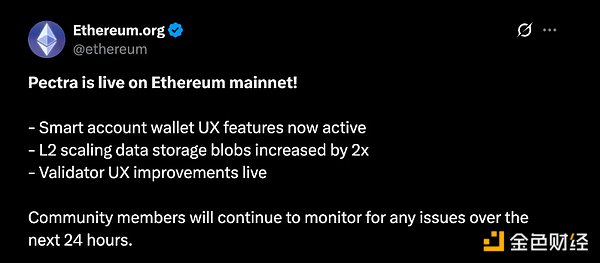Source: Franklin Bi, Pantera Capital partner; Translated by: AIMan@Golden Finance
Ethereum's recent Pectra upgrade has been launched on the mainnet.

If Ethereum is a city, then Pectra is like upgrading the city's infrastructure.
This isn’t some new skyline or shiny skyscraper. This is the boring but vital work that makes entire cities faster, safer, and better for everyone who lives there.
Pectra is more than just an incremental improvement in developer ergonomics or a few gwei cuts. This upgrade actually revolutionizes the economics and UX of Ethereum-based applications, enough to unlock new product categories and business models (see the list at the end of this post!).
Pectra is a price-performance inflection point for Ethereum
Pectra bundles 11 Ethereum Improvement Proposals (EIPs) at Ethereum’s execution and consensus layers to address some of its most vexing pain points: clunky UX, high data availability costs, and slow validator operations.
But why is Pectra a “turning point”? Because it marks the price/performance tipping point on Ethereum: a critical threshold where products become more attractive due to a change in their cost structure relative to performance/value.
Pectra’s protocol improvements can now push on-chain economics and user experience beyond the price/performance threshold, enabling entirely new categories of viable products and business models. When lower costs, better performance, and a better user experience come together, magic happens.
Lowering on-chain costs below the pain threshold
Before Pectra, many on-chain operations (micro perpetual transactions, low-value NFT minting, batch revenue rebalancing) had gas pricing that was too expensive or unpredictable to support sustainable projects.
Pectra’s ~30%-50% gas reduction and blob throughput boost compresses these costs to “not worth considering” levels (e.g., sub-$0.05 minting fees, sub-$0.10 micro perpetual transactions). This means that today’s “nice to have” features will become core revenue drivers in the future.
How it works:
Proto‑Danksharding with Blobs (EIP‑4844 + EIP‑7691): Pectra introduces the first layer of Danksharding, so-called “proto‑danksharding”, via Blobs. Blobs are a new data availability primitive that decouples Rollup payloads from Ethereum’s execution state. You can think of Blobs as extra cargo space on an airplane: instead of stuffing all your packages into the passenger cabin, you unload cargo into the cargo hold, freeing up space and reducing costs. Rollups like Optimism and Arbitrum can now increase calldata per block by up to 50% while cutting the price in half. For end users, this means 30% to 50% lower transaction fees when swapping tokens, bridging assets, or interacting with DeFi protocols on L2.
Calldata Gas Repricing (EIP-7623): Calldata (the raw instructions that users send to smart contracts) will become significantly cheaper. Think of a stamp: if each stamp costs less, you can send longer letters without spending as much. Pectra reduces the gas cost per byte, making batched transactions (multi-send airdrops, batch vault rebalancing, multi-NFT minting) up to 40% cheaper. Builders can bundle multiple operations into a single transaction, avoiding unpredictable fee spikes.
Fix the User Experience with Major Improvements
Wallet Approval Fatigue. Gas Popups. Multi-step Signup Flow. These clunky experiences are bearable for hardcore crypto fans, but completely alien to a wider audience.
Pectra’s gas abstraction and smoother user experience make on-chain interactions as smooth as Web2’s one-click experience. When users no longer need to struggle with MetaMask or gas limits, the user scale can eventually scale from millions to hundreds of millions.
How it works:
Gas Abstraction and Smart Contract Wallets (EIP-7702 + EIP-7840): Pectra improves “account code” support, enabling smart contract wallets to sponsor gas directly for end users. Imagine driving through a toll booth and finding that your favorite app has already paid the toll for you - no need to stop or look around for tokens. MetaMask no longer pops up on every approval or redemption. Developers can bundle the painfully familiar process of “Approve —> Redeem —> Approve —> Cross-chain Bridge —> Approve” into a single transaction paid by the DApp, significantly reducing the entry friction for non-technical users.
Smoother Staking Process (EIP-7251 + EIP-7002): Improvements to the staking user experience are often unnoticed, but they are significant. Pectra increased the validator staking limit from 32 ETH to 2,048 ETH, allowing node operation providers to consolidate staking, just like merging small bank accounts into a high-yield fund, thereby simplifying management and reducing fees. The triggerable exit mechanism becomes instant, which simplifies the user experience of liquidity staking platforms and makes staking operations as intuitive as withdrawing money at an ATM.
Minor Engine Tweaks (EIP-7846, EIP-7617): Small gas refunds and opcode tweaks may sound insignificant, but they add up across thousands of contracts, shaving microseconds and microgwei off everyday on-chain computations.
What Pectra Suggests for Ethereum’s Future
Optimism That Ethereum Is “Done”
Critics of Ethereum often point to its slow governance and fragmented client support. Pectra dispels those concerns: In less than 24 months, Ethereum has rolled out Shanghai (April 2023), Dencun (March 2024), and now Pectra (May 2025). 11 EIPs in unison, without backtracking or ripples. I expect future upgrades to be more frequent than the current annual frequency. The biggest takeaway: Ethereum’s “upgrade flywheel” is spinning at full speed, reducing protocol risk for developers and investors.
Better Governance = Faster Delivery
Pectra’s “meta-EIP” umbrella (EIP-7600) demonstrates progress in Ethereum governance. Multiple working groups, off-chain forums, and on-chain signals converge into a unified whole. It’s like multiple teams working together to launch a space mission at the best time — only this time it’s once a year instead of once every few decades. Now builders can view upgrade timelines as predictable milestones instead of moving targets.
Roadmap Confidence = Investor Confidence
By launching proto-Danksharding today, Ethereum paves the way for full implementation of Danksharding in the near future. After Pectra, builders and investors can reasonably build a transparent roadmap to achieve 1 million TPS throughput on the L2 network. As the gas cost floor steadily decreases, business models can anticipate transactions below $0.10, transforming long-term planning from guesswork to granular predictions.

New Opportunities for Builders and Founders
Pectra In addition to being able to build existing DeFi or NFT applications at a lower cost, it changes the types of applications worth building. Micro perpetual markets. Continuous auctions. Gas-sponsored social dApps. Enterprise-grade staking-as-a-service. These features and products become viable and potentially lucrative.
Pectra is not just another upgrade, it’s the turning point for Ethereum base layer enhancements to move from incremental optimization to commercialization.
Here is a non-exhaustive list of products and use cases after Pectra:
DeFi
Micro Perpetuals and Mini Auctions
Calldata costs are cut in half, meaning you can launch a perpetual market per second or a continuous auction for real-world assets with an entry fee of less than $0.05. Imagine running a micro stock exchange on every block.
Composable Yield Libraries & Orchestration
Blob throughput makes chaining 5-10 yield strategies in a single multi-way call as easy as ordering multiple dishes with one click and paying one delivery fee. Startups can charge performance fees on top of management fees, creating recurring revenue for decentralized portfolio managers.
Flash‑Bundle SDK
Bundles flash loans, MEV capture, and gas sponsorship into one SDK. It’s like bundling internet, TV, and phone into one subscription, only for high-frequency DeFi primitives.
Consumer Social Apps + NFTs
Minting at Scale:
Pectra’s calldata repricing technology reduces gas fees by ~30%, and the total cost of 10,000 mints is now less than $1,000 — making it as cheap to generate artistic mints as viral social media campaigns. While still catching up to compressed NFTs/cNFTs on Solana, which can achieve low-cost minting of 1 million, there is no doubt that great progress has been made.
Social Entry Sponsored by Gas
Smart contract wallets can subsidize users' first few transactions, for example, providing a free first cup of coffee or zero-fee transactions, turning cold wallets into active community members through frictionless token interaction.
Games and Mobile Apps
Smooth In-Game Economy
Pre-charged Gas Points unlock dozens of microtransactions per game session. Imagine batching manufacturing, market bidding, loot collection, etc., all in one go. This brings a AAA mobile game user experience without popups.
Dynamic Session Compression
Clients record off-chain operations and submit a single compressed blob at the end of the session. It’s like compressing a bunch of files before uploading, keeping gas costs flat and predictable.
Enterprise & Infrastructure
Enterprise-Grade Staking + Custody
Increasing the validator cap to 2,048 ETH could reduce the number of nodes for large staking pools by 64x. Imagine consolidating multiple offices into a single headquarters, greatly improving efficiency and creating a more diverse “business district.”
Stateless + Light Client Services
EIP-7685’s state hash unification mechanism lays the foundation for Ethereum’s Verkle trees to support stateless clients. This shift is like streaming content on demand instead of carrying around a library full of books or CDs.
Data Availability Middleware
Blob proofs power off-chain DA networks (aka middleware) that guarantee 99.99% availability, just like a CDN guarantees fast delivery of content around the world.
SDKs and Tools
Gas Sponsorship and Relay Libraries
The new JS/TS SDK will combine bundler selection, fee estimation, and gas sponsorship into a simple function call - similar to how payment APIs integrate credit card transactions.
Calldata Compressor and Multi-Call Optimizer
The Hardhat/Foundry plugin analyzes contract flow, automatically batches calls into blobs, and displays gas savings estimates at compile time, just like a code checker can highlight inefficiencies. This is a huge quality of life improvement for developers.
Observability Dashboards
Metrics suites for blob utilization, sponsor ROI, and proto‑dank load distribution will emerge, providing advanced analytics for builders who need granular visibility.
Post-Pectra: Time to Build and Upgrade
Pectra won’t grab headlines with flashy features. It won’t reinvent Ethereum. It will strengthen Ethereum by strengthening the core, while raising the ceiling for on-chain economics and experiences.
Products that were once on the brink of survival become not only viable, but also bankable and scalable. This is a commercial inflection point for Ethereum, removing a huge barrier to mainstream user experience, solidifying Ethereum’s accelerating upgrade cadence, and unlocking entirely new categories of products, from micro-apps to consumer apps.
Prototype Pectra native features today and seize the new benefits Pectra brings. The next generation of Ethereum-powered products is coming.
 Weiliang
Weiliang
 Weiliang
Weiliang Catherine
Catherine Anais
Anais Alex
Alex Miyuki
Miyuki Miyuki
Miyuki Weiliang
Weiliang Kikyo
Kikyo Joy
Joy Catherine
Catherine